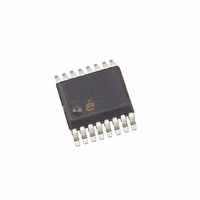ISL6549CAZA-T Intersil, ISL6549CAZA-T Datasheet - Page 12

ISL6549CAZA-T
Manufacturer Part Number
ISL6549CAZA-T
Description
IC CTRLR PWM SYNC BUCK 16-QSOP
Manufacturer
Intersil
Datasheet
1.ISL6549CAZR5213.pdf
(18 pages)
Specifications of ISL6549CAZA-T
Pwm Type
Voltage Mode
Number Of Outputs
2
Frequency - Max
1MHz
Duty Cycle
100%
Voltage - Supply
4.75 V ~ 13.2 V
Buck
Yes
Boost
No
Flyback
No
Inverting
No
Doubler
No
Divider
No
Cuk
No
Isolated
No
Operating Temperature
0°C ~ 70°C
Package / Case
16-QSOP
Frequency-max
1MHz
Lead Free Status / RoHS Status
Lead free / RoHS Compliant
Other names
ISL6549CAZA-TTR
Available stocks
Company
Part Number
Manufacturer
Quantity
Price
Part Number:
ISL6549CAZA-T
Manufacturer:
INTERSIL
Quantity:
20 000
A stable control loop has a gain crossing with close to a
-20dB/decade slope and a phase margin greater than 45°.
Include worst case component variations when determining
phase margin. The mathematical model presented makes a
number of approximations and is generally not accurate at
frequencies approaching or exceeding half the switching
frequency. When designing compensation networks, select
target crossover frequencies in the range of 10% to 30% of
the switching frequency, F
Linear Controller Feedback Compensation
For most situations, no external compensation is required for
the linear output. As long as the output capacitor (C
large (>100µF) and so is its ESR (>20mW), then it should be
stable for loads as low as 10mA up to at least 4A. If smaller
values of capacitance and/or ESR are desired, then special
considerations may be required to add external
compensation (as shown in Figure 8).
Component Selection Guidelines
Output Inductor Selection
The output inductor is selected to meet the output voltage
ripple requirements and minimize the converter’s response
time to the load transient. The inductor value determines the
converter’s ripple current and the ripple voltage is a function of
the ripple current. The ripple voltage and current are
approximated by Equation 10.
Increasing the value of inductance reduces the ripple current
and voltage. However, the large inductance values reduce the
converter’s response time to a load transient (and usually
increases the DCR of the inductor, which decreases the
efficiency). Increasing the switching frequency (F
given inductor also reduces the ripple current and voltage.
∆I =
FIGURE 11. ASYMPTOTIC BODE PLOT OF CONVERTER GAIN
0
V
------------------------------- -
LOG
IN
F
20
SW
- V
log
x L
OUT
⎛
⎝
R2
------- -
R1
⎞
⎠
•
V
--------------- -
F
V
OUT
Z1
IN
F
F
LC
Z2
SW
F
F
.
12
CE
∆V
P1
OUT
F
0
F
20
P2
= ∆I x ESR
log
G
CL
COMPENSATION GAIN
d
---------------------------------
OPEN LOOP E/A GAIN
CLOSED LOOP GAIN
MAX V
G
V
MODULATOR GAIN
MOD
OSC
FREQUENCY
⋅
SW
IN
) for a
OUT2
G
(EQ. 10)
FB
) is
ISL6549
One of the parameters limiting the converter’s response to a
load transient is the time required to change the inductor
current. Given a sufficiently fast control loop design, the
ISL6549 will provide either 0% or 100% duty cycle in
response to a load transient. The response time is the time
required to slew the inductor current from an initial current
value to the transient current level. During this interval, the
difference between the inductor current and the transient
current level must be supplied by the output capacitor.
Minimizing the response time can minimize the output
capacitance required.
The response time to a transient is different for the application
of load and the removal of load. Equation 11 gives the
approximate response time interval for application and
removal of a transient load:
where: I
response time to the application of load, and t
response time to the removal of load. With a +5V input
source, the worst case response time can be either at the
application or removal of load and dependent upon the output
voltage setting. Be sure to check both of these equations at
the minimum and maximum output levels for the worst case
response time.
Output Capacitors Selection
An output capacitor is required to filter the output and supply
the load transient current. The filtering requirements are a
function of the switching frequency and the ripple current. The
load transient requirements are a function of the slew rate
(di/dt) and the magnitude of the transient load current. These
requirements are generally met with a mix of capacitors and
careful layout.
Modern microprocessors produce transient load rates above
1A/ns. High frequency capacitors initially supply the transient
and slow the current load rate seen by the bulk capacitors.
The bulk filter capacitor values are generally determined by
the ESR (effective series resistance) and voltage rating
requirements rather than actual capacitance requirements.
High frequency decoupling capacitors should be placed as
close to the power pins of the load as physically possible. Be
careful not to add inductance in the circuit board wiring that
could cancel the usefulness of these low inductance
components. Consult with the manufacturer of the load on
specific decoupling requirements. And keep in mind that not all
applications have the same requirements; some may need
many ceramic capacitors in parallel; others may need only one.
Use only specialized low-ESR capacitors intended for
switching-regulator applications for the bulk capacitors.
The bulk capacitor’s ESR will determine the output ripple
voltage and the initial voltage drop after a high slew-rate
t
RISE
=
TRAN
------------------------------- -
V
L
O
IN
×
–
I
V
TRAN
is the transient load current step, t
OUT
t
FALL
=
L
------------------------------ -
O
V
×
OUT
I
TRAN
FALL
September 22, 2006
RISE
is the
(EQ. 11)
is the
FN9168.2












